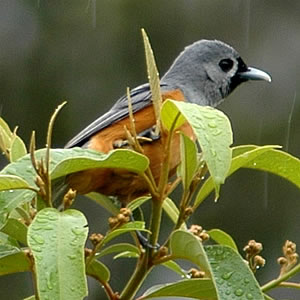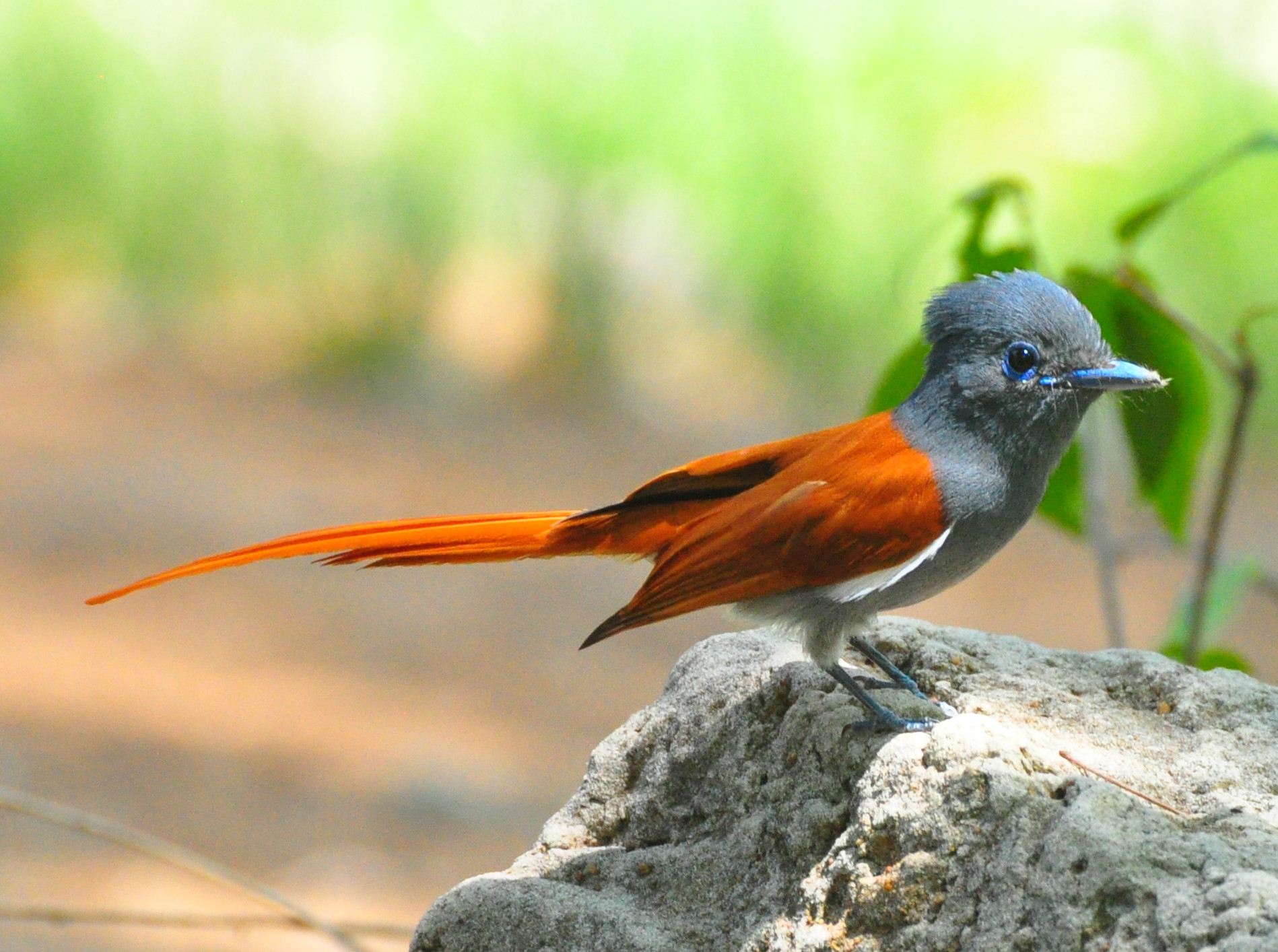|
Monarchidae
The monarchs or monarch flycatchers (family Monarchidae) comprise a family of over 100 passerine birds which includes shrikebills, paradise flycatchers, and Grallina, magpie-larks. Monarchids are small insectivore, insectivorous songbirds with long tails. They inhabit forest or woodland across sub-Saharan Africa, south-east Asia, Australasia, and a number of Pacific islands. Only a few species migrate. Many species decorate their cup-shaped nests with lichen. Taxonomy Some of the one hundred or more species making up the family were previously assigned to other groups, largely on the basis of general morphology or behaviour. The magpie-lark, for example, was assigned to the same family as the white-winged chough, since both build unusual nests from mud rather than vegetable matter. That family, Grallinidae, is now considered a Synonym (taxonomy), synonym of Monarchidae. It was formerly considered to have four species. The magpie-lark and the torrent-lark were moved into Monarc ... [...More Info...] [...Related Items...] OR: [Wikipedia] [Google] [Baidu] |
Trochocercus
''Trochocercus'' is a genus of bird in the family Monarchidae. Described by Jean Cabanis in 1850, the name ''Trochocercus'' is a combination of the Greek language, Greek words ''trokhos'' meaning "circular" or "round" and ''kerkos'', meaning "tail". Taxonomy and systematics Extant species After three former species were transferred to the genus ''Elminia'' in 2009, the genus ''Trochocercus'' now contains the following two remaining species: Former species Formerly, some authorities also considered the following species (or subspecies) as species within the genus ''Trochocercus'': * Bedford's paradise flycatcher (as ''Trochocercus bedfordi'') * Dusky crested flycatcher (as ''Trochocercus nigromitratus'') * White-bellied crested flycatcher (as ''Trochocercus albiventris'') * White-tailed crested flycatcher (as ''Trochocercus albicaudatus'' or ''Trochocercus albonotata'') References Trochocercus, Monarchidae Bird genera Birds of Sub-Saharan Africa Taxonomy articles cre ... [...More Info...] [...Related Items...] OR: [Wikipedia] [Google] [Baidu] |
Torrent-lark
The torrent-lark (''Grallina bruijnii'') is a species of bird in the family Monarchidae found on New Guinea. Its natural habitats are subtropical or tropical moist lowland forests and subtropical or tropical moist montane forest Montane ecosystems are found on the slopes of mountains. The alpine climate in these regions strongly affects the ecosystem because temperatures lapse rate, fall as elevation increases, causing the ecosystem to stratify. This stratification is .... Though most Monarchidae birds make their nests out of plant materials, the torrent-lark makes its nest out of mud. References Grallina Birds of the New Guinea Highlands Birds described in 1875 Taxonomy articles created by Polbot {{Monarchidae-stub ... [...More Info...] [...Related Items...] OR: [Wikipedia] [Google] [Baidu] |
Buff-bellied Monarch
The buff-bellied monarch (''Neolalage banksiana'') is a species of bird in the family Monarchidae. It is monotypic within the genus ''Neolalage''. It is endemic to Vanuatu, where its natural habitat is subtropical or tropical moist lowland forests. The buff-bellied monarch was originally described in the genus '' Lalage''. Alternate names include Banksian monarch, buff-bellied flycatcher, New Hebrides flycatcher, New Hebrides monarch, Pacific monarch (a name shared with the pale-blue monarch The pale-blue monarch (''Hypothymis puella'') is a small passerine bird in the family Monarchidae endemic to eastern Indonesia. Taxonomy and systematics The pale-blue monarch was originally described in the genus ''Myiagra'' and then classified ...) and Vanuatu flycatcher. References buff-bellied monarch Birds of Vanuatu Endemic birds of Vanuatu buff-bellied monarch buff-bellied monarch Taxonomy articles created by Polbot {{Monarchidae-stub ... [...More Info...] [...Related Items...] OR: [Wikipedia] [Google] [Baidu] |
Mayrornis
''Mayrornis'' is a genus of bird in the family Monarchidae found in the Solomon Islands and Fiji. The name ''Mayrornis'' is a compound word. The first part, ''Mayr'', commemorates Ernst Walter Mayr, a German ornithologist and systematist. The second part, ''ornis'', is the Greek Greek may refer to: Anything of, from, or related to Greece, a country in Southern Europe: *Greeks, an ethnic group *Greek language, a branch of the Indo-European language family **Proto-Greek language, the assumed last common ancestor of all kno ... word meaning "bird". Established by Frank Alexander Wetmore in 1932, it contains the following species: References Bird genera Taxa named by Alexander Wetmore Taxonomy articles created by Polbot {{Monarchidae-stub ... [...More Info...] [...Related Items...] OR: [Wikipedia] [Google] [Baidu] |
Paradise Flycatcher
The paradise flycatchers (''Terpsiphone'') are a genus of birds in the family Monarchidae. The genus Range (biology), ranges across Africa and Asia, as well as a number of islands. A few species are bird migration, migratory, but the majority are resident. The most telling characteristic of the genus is the long tail streamers of the males of many species. In addition to the long tails the males and females are sexual dimorphism, sexually dimorphic and have rufous, black and white plumage. Taxonomy and systematics The genus ''Terpsiphone'' was introduced by the German zoologist C. L. Gloger, Constantin Gloger in 1827. The type species was subsequently designated as the Indian paradise flycatcher. The name is from the Ancient Greek ''terpsi '' "delighting in" and ''phonos'' "voice". The genus contains 17 species: Former species Formerly, some authorities also considered the following species (or subspecies) as species within the genus ''Terpsiphone'': * Cerulean flycatcher (as ... [...More Info...] [...Related Items...] OR: [Wikipedia] [Google] [Baidu] |
Grallina
''Grallina'' is a genus of passerine bird native to Australia and New Guinea. It is a member of a group of birds termed monarch flycatchers. Taxonomy Higher taxonomy Long thought to be a member of the mudnest builder family Corcoracidae, the magpie-lark and torrent lark have been reclassified in the family Monarchidae (the monarch flycatchers). The two make up a lineage that split off early from other monarchs and has no close relatives within the family. The monarch flycatchers are considered either as a subfamily Monarchinae, together with the fantails as part of the drongo family Dicruridae, or as a family Monarchidae in its own right. More broadly, they belong to the Corvida parvorder comprising many tropical and Australian passerines including pardalotes, fairy-wrens and honeyeaters as well as crows. Species Two species A species () is often defined as the largest group of organisms in which any two individuals of the appropriate sexes or mating types c ... [...More Info...] [...Related Items...] OR: [Wikipedia] [Google] [Baidu] |
Pomarea
''Pomarea'' is a genus of birds in the monarch flycatcher family Monarchidae. The genus is restricted to the islands of Polynesia. The monarchs of this genus are around 15–19 cm long and most have sexual dimorphism, sexually dimorphic plumage. Taxonomy and systematics Extant species The genus ''Pomarea'' contains six extant species, including one possible extinct: * Rarotonga monarch (''Pomarea dimidiata'') * Tahiti monarch (''Pomarea nigra'') * Marquesan monarch (''Pomarea mendozae'') * Ua Pou monarch (''Pomarea mira'') (Possibly extinct) * Iphis monarch (''Pomarea iphis'') * Fatu Hiva monarch (''Pomarea whitneyi'') Extinct species * †Maupiti monarch (''Pomarea maupitiensis'') * †Nuku Hiva monarch (''Pomarea nukuhivae'') * †Eiao monarch (''Pomarea fluxa'') Former species Formerly, some authorities also considered the following species (or subspecies) as species within the genus ''Pomarea'': *Bougainville monarch (as ''Pomarea erythrosticta'') *Chestnut-bellied mona ... [...More Info...] [...Related Items...] OR: [Wikipedia] [Google] [Baidu] |
Terpsiphone
The paradise flycatchers (''Terpsiphone'') are a genus of birds in the family Monarchidae. The genus ranges across Africa and Asia, as well as a number of islands. A few species are migratory, but the majority are resident. The most telling characteristic of the genus is the long tail streamers of the males of many species. In addition to the long tails the males and females are sexually dimorphic and have rufous, black and white plumage. Taxonomy and systematics The genus ''Terpsiphone'' was introduced by the German zoologist Constantin Gloger in 1827. The type species was subsequently designated as the Indian paradise flycatcher. The name is from the Ancient Greek ''terpsi '' "delighting in" and ''phonos'' "voice". The genus contains 17 species: Former species Formerly, some authorities also considered the following species (or subspecies) as species within the genus ''Terpsiphone'': * Cerulean flycatcher (as ''Zeocephus rowleyi'') * Blue-mantled crested flycatcher (as '' ... [...More Info...] [...Related Items...] OR: [Wikipedia] [Google] [Baidu] |
Hypothymis
''Hypothymis'' is a genus of birds in the family Monarchidae. The genus was introduced by the German zoologist Friedrich Boie in 1826 with the black-naped monarch (''Hypothymis azurea'') as the type species. The word ''Hypothymis '' is from the Ancient Greek ''hupothumis'', the name of an unidentified bird mentioned by the playwright Aristophanes. Species The genus contains four species: References Hypothymis, Bird genera Birds of Southeast Asia, Taxa named by Friedrich Boie Taxonomy articles created by Polbot {{Monarchidae-stub ... [...More Info...] [...Related Items...] OR: [Wikipedia] [Google] [Baidu] |
Clytorhynchus
The shrikebills are the monarch flycatcher genus ''Clytorhynchus''. The five species have long laterally compressed bills similar to true shrikes that give them their names. The genus is endemism, endemic to the islands of Melanesia and western Polynesia. The shrikebills are insectivorous, and use their large heavy bills to explore tangles of dead leaves and dead wood; an unusual foraging strategy for their family. Their diet may also include small fruits and lizards. Taxonomy and systematics Extant species The genus ''Clytorhynchus'' contains the following species: Former species Formerly, some authorities also considered the following species (or subspecies) as species within the genus ''Clytorhynchus'': *Sangihe whistler (as ''Pinarolestes sanghirensis'') *Little shrikethrush (as ''Pinarolestes megarhynchos'' or ''Pinarolestes megarhynchus'') References Clytorhynchus, Birds of Melanesia Taxonomy articles created by Polbot {{Monarchidae-stub ... [...More Info...] [...Related Items...] OR: [Wikipedia] [Google] [Baidu] |
Shrikebill
The shrikebills are the monarch flycatcher genus ''Clytorhynchus''. The five species have long laterally compressed bills similar to true shrikes that give them their names. The genus is endemic to the islands of Melanesia and western Polynesia Polynesia ( , ) is a subregion of Oceania, made up of more than 1,000 islands scattered over the central and southern Pacific Ocean. The indigenous people who inhabit the islands of Polynesia are called Polynesians. They have many things in .... The shrikebills are insectivorous, and use their large heavy bills to explore tangles of dead leaves and dead wood; an unusual foraging strategy for their family. Their diet may also include small fruits and lizards. Taxonomy and systematics Extant species The genus ''Clytorhynchus'' contains the following species: Former species Formerly, some authorities also considered the following species (or subspecies) as species within the genus ''Clytorhynchus'': * Sangihe whistler (as ''Pinarol ... [...More Info...] [...Related Items...] OR: [Wikipedia] [Google] [Baidu] |
Magpie-lark
The magpie-lark (''Grallina cyanoleuca''), also known as wee magpie, peewee, peewit, mudlark or Murray magpie, is a passerine bird native to Australia, Timor and southern New Guinea. The male and female both have black and white plumage, though with different patterns. John Latham (ornithologist), John Latham described the species in 1801. Long thought to be a member of the mudnest builder family Corcoracidae, it has been reclassified in the family Monarchidae (the monarch flycatchers). Two subspecies are recognized. Taxonomy and systematics The magpie-lark was originally described by the English ornithologist John Latham (ornithologist), John Latham in the genus ''Corvus'' in 1801 (as ''Corvus cyanoleucus''). Its species name is derived from the Ancient Greek words ''cyanos'' "dark blue" and ''leukos'' "white" despite the black and white plumage. However, there can be a bluish sheen to the black back. In the same publication, Latham described the same species as ''Gracula picata ... [...More Info...] [...Related Items...] OR: [Wikipedia] [Google] [Baidu] |








